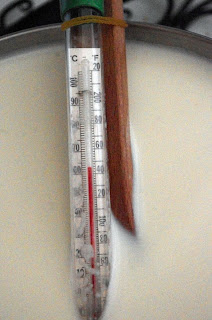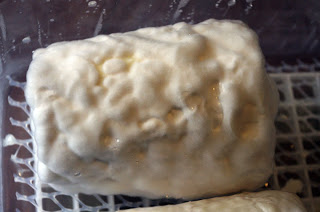I had received this wonderful book called Homemade Cheese: Recipes for 50 Cheese from Artisan Cheesemakers by Janet Hurst to review. I’ve been making some cheese with our goat’s milk but not very much because they don’t produce a lot. I wanted to get more practice but it was going to take us a while to stock up on goat milk.
The thing I really enjoyed about this book was that it was written by a goat owner so most of the cheese recipes could be done using goat milk. For each recipe she also includes with each recipe what equipment you will need for that type of cheese. The only issue I did find was that she didn’t tell you how many molds you needed for each recipe.
At the time I received the book I had only tried mozzarella, chevre and Monterey Jack. Both came out well but I’m such a sucker for soft cheese.
Soft cheeses, like brie can be difficult to make. But I guess you could say I’m a bit of an overachiever. I didn’t, however, want to do just a brie. I had my heart set on doing Bucheron, which is an aged chevre. It’s difficult to find and one I had really never heard of. I definitely had never seen a recipe for it before. This recipe was going to take 3 days to make so I made sure to do it on a weekend I was going to be home for. It required 2 gallons of goat milk which was going to take us quite awhile to stockpile. To stockpile raw milk we simply froze quart jars of it as we collected it until we got all we needed.
I had 4 small molds for making chevre, which ended up being enough. Five molds probably would have been more ideal though because I was really having to cram the curds into the four to make them fit. I also needed cheese mats, and a food grade plastic box to allow the cheese to retain moisture and keep the cultures from contaminating the wine fridge.
The first thing I had to do to make it was pasteurize the milk since it’s a soft cheese and isn’t aged long enough. I really hate pasteurizing milk just because it can take so long but if I wanted to make this cheese I was going to have to.
To pasteurize you need to heat the milk to 145 deg F and hold it there for 30 minutes stirring to keep it evenly heated. I find that my floating brewing thermometer works best for this but I have to rubberband it to the stirring spoon because my pot isn’t deep enough for it to float. After the 30 minutes is up you want to cool it off as quickly as possible in an ice bath. I cooled it of to 86 deg F so I could inoculate the milk without reheating it.
This recipe required a Mesophilic DVI MA starter culture, Penicillum candidum and Geotrichum candidum, rennet and a brine solution.
Once the milk was down to 86 deg F I simply added the cultures, stirring until well blended. I then added the rennet stirring up and down. I left it overnight to firm up.
Without cutting the curds I scooped them into the molds filling them. The molds only took about 2/3s of the curds. I let the curds sit for just over 4 hours and then refilled the molds, packing the rest of the curds in. I allowed them to sit overnight to completely drain. The next morning I removed the curds from the molds and brined them for 10 minutes.
The brine was made up of 2 pounds of noniodized salt mixed into 1 gallon of water. Heat up the water until it’s nearly boiling and mix in the salt until it’s dissolved. When it cools some of the salt may precipitate out. You know the salt content is right when the cheese floats. If the cheese sinks there’s not enough salt. This is good to know because you keep the brine to reuse – adding water and salt when needed. Over time it will develop it’s own character from whey and cultures that are slowly added with each batch of cheese. Some cheesemakers have had the same brine for decades.
After I brined the cheeses I laid them on the cheese mats and put them in the box. The first day I repositioned the cheeses several times. I put the box in my wine fridge set about 55 deg F then for the next week I turned them to make sure they were evenly drained and allowing the mold to develop evenly over the cheese.
After three more weeks of aging the cheese was ready. It was much milder than chevre. It no longer had that bite that I associate with goat cheese. It was distinctively different from brie though being more delicate. It’s not creamy like brie either. It’s a delightful cheese that I will make again.






Yummy! I'll have to try this. Question: when you make chevre, do you pasteurize? I don't… So I'm wondering if this would really *need* to be pasteurized either, or if the brine and penicillum/geotrichum would be enough to keep the cheese preserved for 3 weeks. Raw bucheron kind of sounds delicious to me.
Also, I've found that unless I use old milk, my cheese never has that gamey, goaty flavor… it's much milder than chevre from the store. I wonder if this has something to do with the fact that it's Nigerian milk (and yours would be similar since Pygmies share ancestry)?
I am also curious how much rennet you use… when I make chevre I use 1/5 of a drop for 4 molds. One of the benefits of raw milk is that it forms curds easily!
Lynda, I don't pasteurize for chevre either. I also don't pasteurize for mozzarella or feta. You don't have to pasteurize hard cheeses as long as you let them age for at least 60 days so that the nasties die. However, you have to pasteurize for these aged soft cheeses because any not-so-good-for-you bacteria can gain a foothold and make you really sick. They aren't served fresh but they aren't aged long enough.
Oh and it's 8 drops of rennet for the 2 gallons of milk.
Would you mind sharing the entire recipe? How much of each culture? Did you use double or single strength rennet? etc. I, too, am having a hard time finding a recipe for Bucheron!
Thanks!
Unfortunately I don’t have permission from the author to reproduce the recipe. However, use a basic Camembert recipe but with goat milk and age it 5-10 weeks.
This is the closest I’ve come to finding a recipe for my favorite cheese. I’m wondering, though – purchased bucheron does have a brie-like layer under the rind. Have you been able to reproduce that aspect of the cheese? The two textures is what attracts me to this one, and I do see that the picture in the book Homemade cheese (I previewed it on Googlebooks) has this lovely brie-like layer as well. Also, what was the weight of finished cheese from 2 gallons of milk?
Thanks!
It does have the softer creamier texture right under the rind. I got about 2lbs of cheese out of 2 gallons of milk.
I have the same book and want to try making bucheron.I think the directions are unclear in the third paragraph. It says “Lay the cheeses on top of the mat . Reposition them several times during the first day.” What I am not clear about is do you air dry them at room temp the first day and then put them in the box and store at 55 degrees or do you immediately put them in a box and store them at 55? What did you do? Thanks!
Drain them at room temperature for the first day and then move them to your ripening area. If you put them in the box before draining they won’t be able to properly drain.